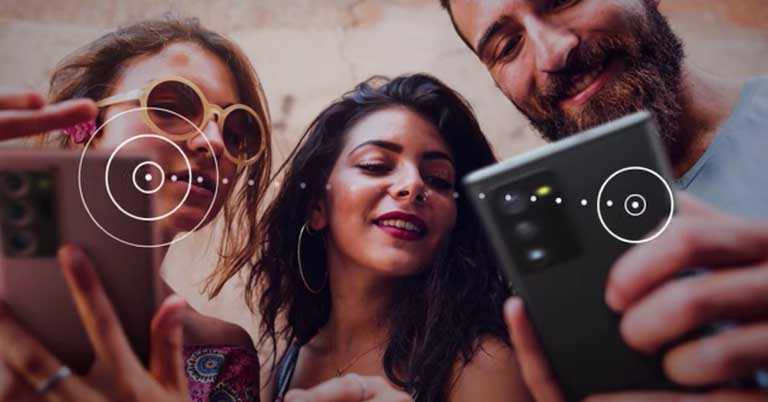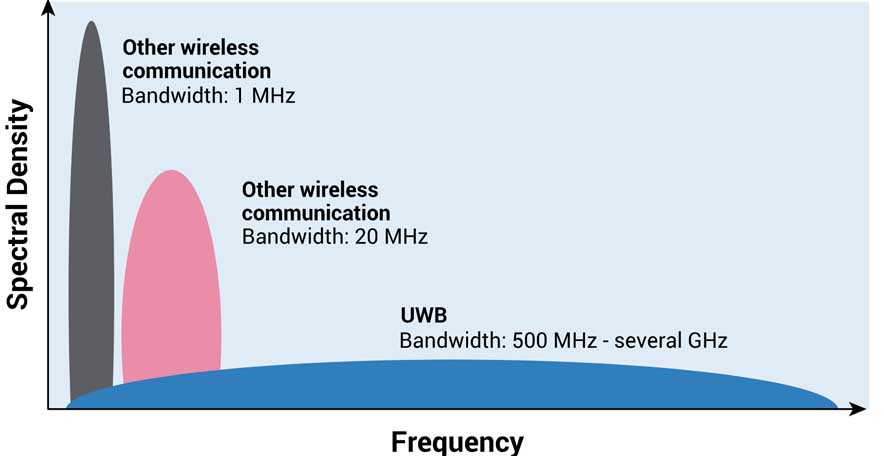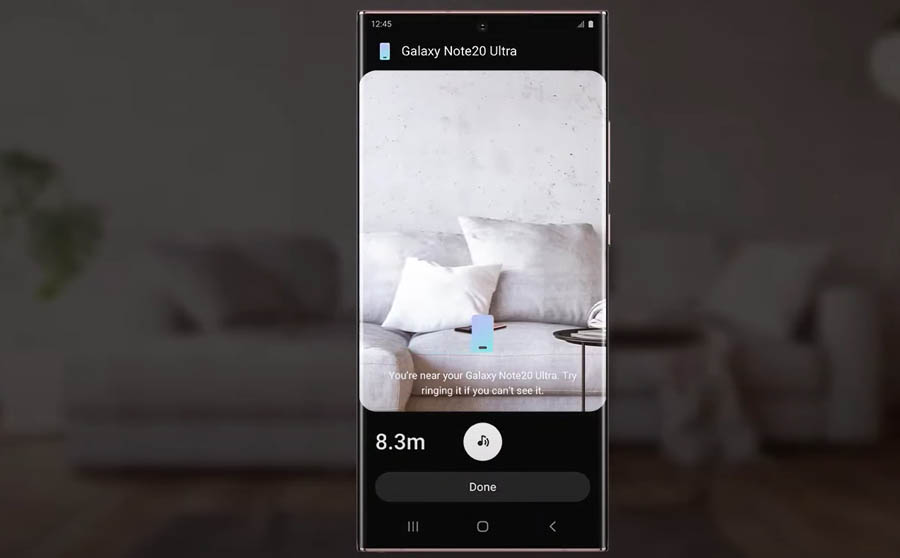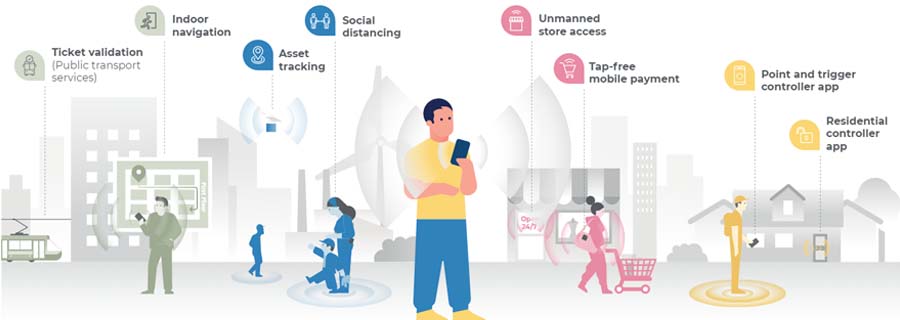
If you are into smartphones, you would probably be familiar with different multiple short-range communication technologies like Bluetooth, WiFi, and NFC. The latter is an especially short-range protocol, operating at just 13.56MHz. As a result, NFC also makes cashless payments more convenient. And now, smartphone brands have started new technology called the Ultra-Wideband (UWB) into their phones. But, what actually is this UWB technology and how will people benefit from its inclusion into their smartphones.
Ultra-Wideband (UWB): An introduction
Like Bluetooth and WiFi, Ultra-Wideband is a short-range communication technology that uses high-frequency radio waves ranging from 3.1GHz to 10.6GHz. Thus, it operates outside of the 2.4GHz band on which most WiFi and Bluetooth devices are based. This cancels out the possibility of UWB signals interfering with nearby WiFi and Bluetooth.

It also has an additional Physical layer specified in the IEEE 802.15.4z which allows it to utilize security measures against attackers.
Ultra-Wideband technology uses a wider channel bandwidth of at least 500MHz (up to 7.5GHz) with short pulses of just 2 seconds. This makes it more precise and accurate than WiFi, Bluetooth, and even NFC.

UWB allows for faster transfer rates while still being energy-efficient and reliable. The accuracy and precision of the technology make it ideal for localization. It can help you track/locate lost devices with great accuracy. The technology is so effective that you can even track objects in real-time while they are still in motion.
Ultra-Wideband in smartphones
Apple was the first smartphone manufacturer to incorporate the Ultra-Wideband in its smartphones. The U1 chip was first used in the iPhone 11 series for AirDrop. Since then, it has also been used in the iPhone 12 lineup and even in the Apple Watch Series 6 and HomePod Mini. The company has not opened about its plan for UWB in its other products but rumors suggest that it will be significant for the upcoming AirTags (similar to Samsung’s SmartTag).
Samsung too has incorporated UWB in its flagship starting from the Galaxy Note 20 Ultra. It has now made its way into devices like Z Fold 2, Samsung Galaxy S21, S21+, and S21 Ultra. The company has been very open about its plans for the technology. Samsung has been working on UWB technology and its application since 2018. It has also been a member of the FIRA Consortium that was formed in 2019 for the development and promotion of UWB technology. There are now over 45 organizations in the consortium including Samsung, NXP, Qualcomm, and HID Global.
Application of UWB in Samsung Galaxy Phones
Since its introduction in the Note 20 Ultra, the Ultra-Wideband chip in the Galaxy devices has been used for Google’s Nearby Share feature among others. It allows the phones to connect to other Android devices and share files and photos. Samsung has also improved its SmartThing Find feature and announced SmartThing+ to make the most of it. With the UWB-enabled SmartTag+, users will be able to locate lost items to the exact location by using the AR Finder.

Samsung is also working on a new feature Digital Key which will replace physical keys with UWB-enabled smartphones. According to the company, users will soon be able to unlock car doors by just approaching them with UWB-enabled phones (which for now, are the S21 Plus and the S21 Ultra). You don’t even need to pull out your phone and tap it against the door. Samsung has announced partnerships with major car manufacturers like Audi, Genesis, Ford, and BMW to use this feature to unlock card doors. But the South Korean tech giant isn’t the first to introduce this possibility as Apple beat Samsung to the punch by announcing a similar feature on the iPhone 12 series.
Other possible use cases

Ultra-Wideband technology has implications far beyond sharing files or unlocking your car door. It can be useful in maintaining social distancing in schools, workplaces, and other public places. The idea here is that when two people get too close to each other, the UWB sensor on their phone will alert the user. Similarly, it can be very useful in inventory and warehouses as the products can be recorded while they are still in motion. Also, it can prove useful in contactless payment, navigation, managing Smart Home, etc.
- Also, check out our review of the Samsung Galaxy Z Fold 2.







![Best Gaming Laptops in Nepal Under Rs. 250,000 (रु 2.5 Lakhs) [2025] Best Gaming Laptops Under 2.5 lakhs in Nepal [Feb 2025 Update]](https://cdn.gadgetbytenepal.com/wp-content/uploads/2025/02/Best-Gaming-Laptops-Under-2.5-lakhs-in-Nepal-Feb-2025-Update.jpg)
![Best Gaming Laptops in Nepal Under Rs. 120,000 (रु 1.2 Lakhs) [2025] Best Budget Gaming Laptops Under Rs 120000 in Nepal 2025 Update](https://cdn.gadgetbytenepal.com/wp-content/uploads/2025/05/Best-Budget-Gaming-Laptops-Under-Rs-120000-in-Nepal-2024-Update.jpg)
![Best Laptops Under Rs. 80,000 in Nepal [2025] Best Laptops Under 80,000 in Nepal March 2025 Update](https://cdn.gadgetbytenepal.com/wp-content/uploads/2025/03/Best-Laptops-Under-80000-in-Nepal-March-2025-Update.jpg)
![Best Laptops Under Rs. 70,000 in Nepal [2025] Best Laptops Under 70,000 in Nepal March 2025 Update](https://cdn.gadgetbytenepal.com/wp-content/uploads/2025/01/Best-Laptops-Under-70000-in-Nepal-March-2025-Update.jpg)
![Best Gaming Laptops in Nepal Under Rs. 200,000 (रु 2 Lakhs) [2025] Best gaming lapotp under 2 lakhs Nepal Feb 2025](https://cdn.gadgetbytenepal.com/wp-content/uploads/2025/01/Best-Gaming-Laptops-Under-2-Lakh-Nepal-Feb-2025-Update.jpg)
![Best Mobile Phones Under Rs. 15,000 in Nepal [Updated 2025] Best Phones Under 15000 in Nepal 2024 Budget Smartphones Cheap Affordable](https://cdn.gadgetbytenepal.com/wp-content/uploads/2024/03/Best-Phones-Under-15000-in-Nepal-2024.jpg)
![Best Mobile Phones Under Rs. 20,000 in Nepal [Updated] Best Mobile Phones Under NPR 20000 in Nepal 2023 Updated Samsung Xiaomi Redmi POCO Realme Narzo Benco](https://cdn.gadgetbytenepal.com/wp-content/uploads/2024/01/Best-Phones-Under-20000-in-Nepal-2024.jpg)
![Best Mobile Phones Under Rs. 30,000 in Nepal [Updated 2025] Best Phones Under 30000 in Nepal](https://cdn.gadgetbytenepal.com/wp-content/uploads/2025/01/Best-Phones-Under-30000-in-Nepal.jpg)
![Best Mobile Phones Under Rs. 40,000 in Nepal [Updated 2025] Best Phones Under 40000 in Nepal 2024 Smartphones Mobile Midrange](https://cdn.gadgetbytenepal.com/wp-content/uploads/2024/02/Best-Phones-Under-40000-in-Nepal-2024.jpg)
![Best Mobile Phones Under Rs. 50,000 in Nepal [Updated 2025] Best Phones Under 50000 in Nepal](https://cdn.gadgetbytenepal.com/wp-content/uploads/2025/01/Best-Phones-Under-50000-in-Nepal.jpg)
![Best Flagship Smartphones To Buy In Nepal [Updated] Best flagship phone 2025](https://cdn.gadgetbytenepal.com/wp-content/uploads/2024/07/Best-Flagship-Phones-who-is-it-ft-1.jpg)